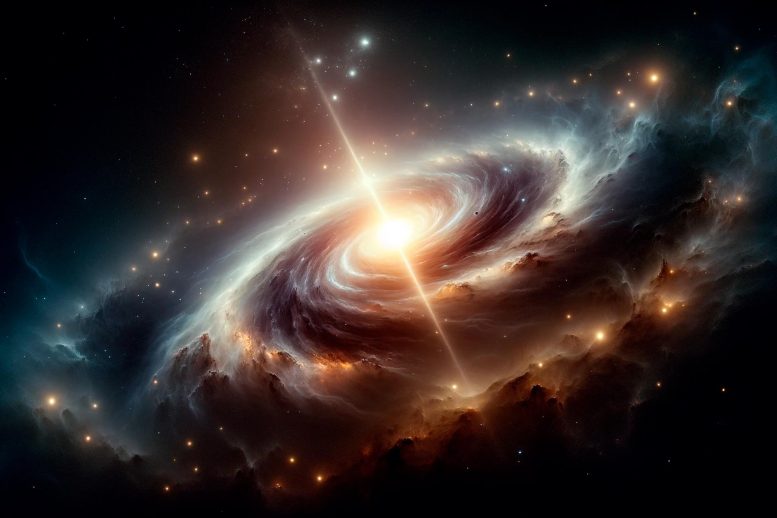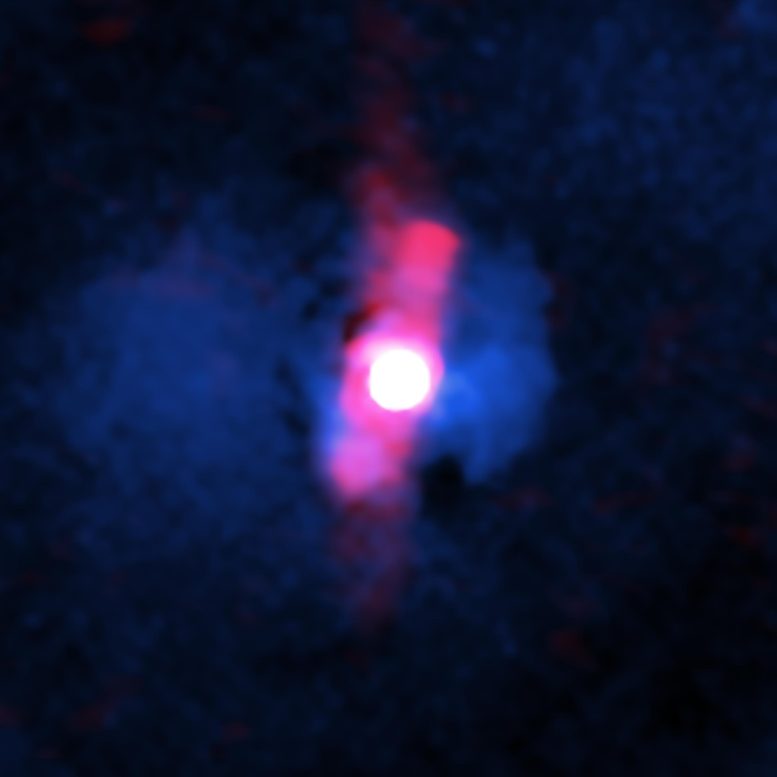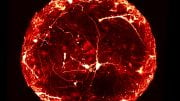
Astronomers studying the quasar H1821+643 found it less impactful on its environment than expected, challenging typical black hole behavior. Credit: SciTechDaily.com
The quasar produces high levels of radiation and powerful jets, but it has less influence on its surroundings than expected.
Astronomers have revealed that a brilliant supermassive black hole is not living up to expectations. Although it is responsible for high levels of radiation and powerful jets, this giant black hole is not as influential on its surroundings as many of its counterparts in other galaxies.
A paper describing these results, by a team including W. Niel Brandt, the Eberly Family Chair Professor of Astronomy and Astrophysics and professor of physics at Penn State, was published in the Monthly Notices of the Royal Astronomical Society.
Close-Up on the Closest Quasar
The study, using data from NASA’s Chandra X-ray Observatory, looked at the closest quasar to Earth. Known as H1821+643, this quasar is about 3.4 billion light-years from Earth and sits in a cluster of galaxies. Quasars are a rare and extreme class of supermassive black holes that are furiously pulling material inwards, producing intense radiation and sometimes powerful jets.
“I have long desired to investigate this remarkable quasar better with Chandra’s keen eyesight,” Brandt said. “I suspected this quasar’s `bark’ would be worse than its `bite’ — that is, its impressive pyrotechnics do not imply similarly impressive environmental impact. I’m delighted that our dogged determination eventually paid off and confirmed my suspicions!”

In the center of this image is the quasar H1821+643, a rapidly growing supermassive black hole that astronomers have found is underachieving, despite producing intense radiation and a jet of particles seen in radio data from the Very Large Array, in red. Located in the middle of a cluster of galaxies, H1821+643 is surrounded by huge quantities of hot gas detected in X-rays by Chandra, in blue. The high temperatures and densities of the hot gas around the quasar shows that the black hole is having a weaker impact on its host galaxy than many of its other counterparts in other galaxy clusters. H1821+643 is the closest quasar to Earth in a cluster of galaxies. It is located 3.4 billion light-years from Earth and the image is about a million light-years across at the distance of the quasar. Credit: X-ray: NASA/CXC/Univ. of Nottingham/H. Russell et al.; Radio: NSF/NRAO/VLA; Image Processing: NASA/CXC/SAO/N. Wolk
Quasar Impact: A Detailed Examination
Most growing supermassive black holes pull material in less quickly than quasars. Astronomers have studied the impact of these more common black holes by observing ones in the centers of galaxy clusters. Regular outbursts from such black holes prevent the huge amounts of superheated gas they are embedded in from cooling down, which limits how many stars form in their host galaxies and how much fuel gets funneled toward the black hole. Much less is known about how much influence quasars in galaxy clusters have on their surroundings.
“We have found that the quasar in our study appears to have relinquished much of the control imposed by more slowly growing black holes,” said Helen Russell of the University of Nottingham in the United Kingdom, who led the new study. “The black hole’s appetite is not matched by its influence.”
Uncovering the Cosmic Paradox
To reach this conclusion, the team used Chandra to study the hot gas that H1821+643 and its host galaxy are shrouded in. The bright X-rays from the quasar, however, made it difficult to study the weaker X-rays from the hot gas.
“We had to carefully remove the X-ray glare to reveal what the black hole’s influence is,” said co-author Paul Nulsen of the Center for Astrophysics, Harvard and the Smithsonian. “We could then see that it’s actually having little effect on its surroundings.”
Gas Dynamics and Future Implications
The team found that the density of gas near the black hole in the center of the galaxy is much higher, and the gas temperatures much lower, than in regions farther away. Scientists expect the hot gas to behave like this when there are little or no sources of energy — typically outbursts from a black hole — to prevent the hot gas from cooling down and flowing toward the center of the cluster.
“The giant black hole is generating a lot less heat than most of the others in the centers of galaxy clusters,” said co-author Lucy Clews of the Open University in the U.K. “This allows the hot gas to rapidly cool down and form new stars, and also act as a fuel source for the black hole.”
The researchers determined that hot gas equivalent to about 3,000 times the mass of the sun per year is cooling to the point that it is no longer visible in X-rays. This rapid cooling can easily supply enough material for the 120 solar masses of new stars observed to form in the host galaxy every year, and the 40 solar masses consumed by the black hole each year.
The team also examined the possibility that the radiation from the quasar is directly causing the cluster’s hot gas to cool down. This involves photons of light from the quasar colliding with electrons in the hot gas, causing the photons to become more energetic and the electrons to lose energy and cool down. The team’s study showed that this type of cooling is probably occurring in the cluster containing H1821+643 but is much too weak to explain the large amount of gas cooling seen.
“While this black hole may be underachieving by not pumping heat into its environment, the current state of affairs will likely not last forever,” said co-author Thomas Braben of the University of Nottingham. “Eventually the rapid fuel intake by the black hole should increase the power of its jets and strongly heat the gas. The growth of the black hole and its galaxy should then drastically slow down.”
Reference: “A cooling flow around the low-redshift quasar H1821+643” by H R Russell, P E J Nulsen, A C Fabian, T E Braben, W N Brandt, L Clews, M McDonald, C S Reynolds, J S Sanders and S Veilleux, 27 January 2024, Monthly Notices of the Royal Astronomical Society.
DOI: 10.1093/mnras/stae026
Brandt’s work on the project was supported by the Penn State Eberly Family Chair in Astronomy and Astrophysics and the Chandra X-ray Center.









According to topological vortex gravitational field theory, vortex motion dominates the evolution of the motion of all things in the universe.
Spin is a natural property of topological vortices. Spin creates everything, spin creates the world, spin creates the future.
According to topological vortex gravitational field theory, vortices (matter) and antivortices (antimatter) are formed simultaneously, with the same geometric shape but opposite directions of rotation. Countless topological vortices make spacetime motion more complex via the synchronous effects of superposition, deflection, and twisting. Therefore, there is so much data coming in from the LHC, the most powerful accelerator in the world, that recording it all has never been an option.
All observable movements in the physical world are inseparable from the interaction of topological vortices, including human observational behavior itself.
The universe does not do algebra, formula or fraction. The universe is geometrythe, and is the superposition, deflection, and twisting of geometric shapes.
Today, we have already entered the era of the internet. With the help of artificial intelligence and big data, discussions on scientific knowledge have become open and transparent. However, a group of editors of so-called academic journals (such as Physical Review Letters, Nature, Science, etc.) are self righteous, self proclaimed, fooling the public, lack remorse, and mystifying themselves. They only care about their own so-called sufficiently high priority rating, general significance, discipline, novelty, etc., and do not care about what science and pseudoscience are.
Science and pseudoscience are not determined by a publication, an organization or a person, nor by you or me, but by mathematics the final say. Physical models must be based on mathematics or mathematical models in order to be scientific, convincing, and in accordance with natural laws.
The origin of geometry lies in the concerns of everyday life. The branch of geometry (mathematics) known as topology has become a cornerstone of modern physics. Topological vortex and antivortex are two bidirectional coupled continuous chaotic systems. They exhibit parity conservation, charge conjugation, and time reversal symmetry. The synchronization effect is extremely important in their interactions. The synchronization effect of the superposition, deflection, and twisting of multiple or countless topological vortices will make spacetime motion more complex. To understand this complex world, physics should respect the authenticity of topological vortex in low dimensional spacetime, rather than simply relying on a few formulas, numbers, or imagined particles.
Spin is a natural property of topological vortices. Spin is synchronized with energy, spin is synchronized with gravitation, spin is synchronized with time, spin is synchronized with evolution. The perpetually swirling topological vortices defy traditional physics’ expectations. One physical properties of topological vortices is them to spontaneously begin to change periodically in time, even though the system does not experience corresponding periodic interference. Therefore, in the interaction of topological vortices, time is both absolute and relative,and physics often requires treating space and time at the same level.
Low-dimensional spacetime matter is the foundation of high-dimensional spacetime matter. Low-dimensional spacetime matter (such as topological vortex) can form new material structures and derive more complex physical properties via interactions and self-organization. It is extremely wrong and irresponsible to imagine low dimensional spacetime matter using high-dimensional spacetime matter,such as a cat in quantum mechanics.
Science must follow mathematical rules. For example, the Standard Model (SM) is considered to be one of the most significant achievements of physics in the 20th century. However, the magnetic moment of μ particle is larger than expected, revealed by a g-2 experiment at Fermilab, suggests that the established theory (such as SM) of fundamental particles is incomplete. Furthermore, the SM omitting gravitation, it not involved the time problem and when the particle movement starts. Mathematics is the foundation of science. Physics must respect the scientific nature of mathematics and mathematical models. The SM must be based on mathematical models in order to be scientific, convincing, and in line with natural laws.
I hope researchers are not fooled by the pseudoscientific theories of the Physical Review Letters (PRL), and hope more people dare to stand up and fight against rampant pseudoscience.
The so-called academic journals (such as Physical Review Letters, Nature, Science, etc.) firmly believe that two high-dimensional spacetime objects (such as two sets of cobalt-60) rotating in opposite directions can be transformed into two objects that mirror each other, is a typical case of pseudoscience rampant.
If researchers are really interested in Science and Physics, you can browse https://zhuanlan.zhihu.com/p/643404671 and https://zhuanlan.zhihu.com/p/595280873.
The Physical Review Letters (PRL) is the most evil, ugly, and dirty publication in the history of science. Nature and Science have been influenced by Physical Review Letters (PRL) and are even more notorious. The behavior of these pseudo-academic publications has seriously hindered the progress and development of human society in science and technology.
I am well aware that my relentless repetition can make some people unhappy, but in the fight against rampant pseudoscience, that’s all I can do.
The latest image of the magnetic fields of the Sagittarius A black hole have intriguing possibilities to theorize about, I take in mind several factors like in any thought take all we know and apply those proofs then cross the boundary to what we don’t understand, from the image the circular rotation has a length segment that takes the fields and inverts them back into itself, now understanding that light does not escape the attraction of the black hole and time is slowed to near nothing, the pressure has increased to a unmeasurable value and the size of the black hole is phenomenal, what we maybe observing at the center is a glimpse of space before the big bang, before time, so intensely negative value, all existence flows to the attraction, I compare this to all black holes but not the same andvintation as bubbles of that collect and filter threw carbonated fluid, what also brings me to this analogy is the lensing of the gravity that reveals dark matter. Positive to negative is what moves creation.
Correction. I meant to write , compare black holes to the advent of bubbles that form in a carbonated fluid.